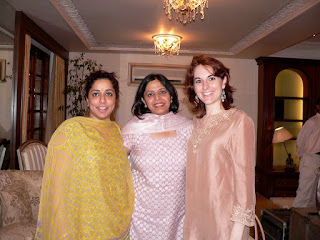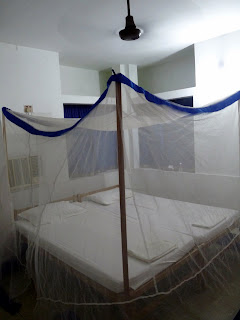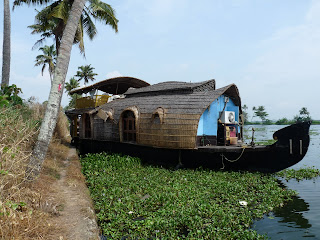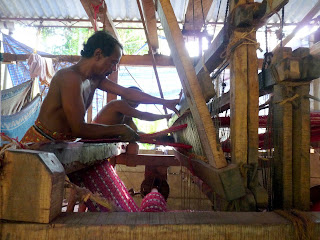Another belated post, written several weeks ago but unable to upload due to limited internet access in India.
India, to me, has a particular smell. It is burning trash mingled with diesel fumes and an occasional whiff of curry spices or incense. After traveling throughout the northwest of the country in late 2004, with repeated visits to Mumbai in the early months of 2005, it seemed that the smell was inescapable. As I walked out of the Kochi airport a few nights ago, I immediately breathed in that unforgettable scent and knew I was in India.
It’s easy to forget how “hard” it is to travel in India. I never thought it was easy the first few times, but I don’t remember being particularly stressed by the daily hassles. I made many Indian friends in Mumbai, initially through people I had met while working as a flight attendant, and they made me feel quite at home in such an unfamiliar place. My friends took me to some of the best restaurants, bars & clubs in the city; I didn’t even realize how lucky I was at the time. We also went to the movies, shopped at the mall, smoked shisha at outdoor cafes and bought tacky souvenirs from street vendors.
 |
| me & friends in Mumbai, March 2005 |
I don’t personally know anyone in Kerala, so Greg & I were pretty dependent on our guesthouse in Fort Kochi to help us “adjust” to India and to plan our southern India sightseeing. While their website claimed they have a travel desk, that turned out not to be the case at all, so we quickly realized we would have to sort out our travel plans on our own. Not to mention that the guesthouse accommodations were very basic - no hot water, no restaurant (but a woman would come and cook a simple breakfast on request), and we had only booked a fan room which meant stifling heat (feels-like temp was 36C) during the day and most of the night. The whole Fort Kochi area is also swarming with mosquitoes and even the strongest repellants won’t prevent bites.
 |
| our mosquito net-draped beds at Bounty Yatra Guesthouse |
Other challenges we encountered almost immediately: nagging tuktuk/taxi drivers, minimal sidewalks on busy roads, few street lights make it difficult to walk safely at night, every car ride is a narrow escape from death, limited internet access (and no wifi), fully booked trains, and no alcohol (a Kerala state regulation - it can only be sold from licensed venues, of which we found one in an expensive hotel, or at a government-run liquor store).
We ended up doing a lot of roaming around on foot, trying to avoid the hottest part of the day with little success. Over three days we visited all the key sights: the Chinese fishing nets, St Francis Church and Santa Cruz Cathedral in Fort Kochi, and the Jewish Synagogue and Jew Town in Mattancherry. We decided to skip the Dutch Palace as it didn’t look like much from the outside. We also ate some good Indian food, although our first few meals (at Pumpkin, Talk of the Town, and Salt’n’Pepper on Princess St) were only so-so in my opinion. The best food we ate was by far at Dal Roti, followed by Chariot Beach Café and Master’s Art Café. The best lassi I drank was at Shiva Dreams. I also re-discovered my favorite thirst-quenching Indian beverage: fresh lime soda (I like mine a little sweet).
 |
| eating a delicious meal at Dal Roti in Fort Kochi |
Although we considered spending a few nights touring the surrounding area (Munnar in particular), we ultimately decided to “save” our hill station adventure for northern India (Darjeeling). However, one of the primary reasons I wanted to visit Kerala was to travel on the backwaters by houseboat, which we did on our last night in the state. We gambled and booked our overnight trip through the guesthouse as they only work with one company, Welcome Cruises, so we only had to choose an A/C or non-A/C room. Due to the heat & mosquitoes we opted for A/C which turned out to be the right decision.
 |
| our houseboat, the Lilly Darling |
The drive to Alleppey takes anywhere from 1.5-2 hours from Fort Kochi. We were driven in a trusty Hindustan Ambassador (no seatbelts, no A/C) by one of the guesthouse staff. We boarded our boat, the Lilly Darling, around noon and quickly learned we would be the only guests (although there were two bedrooms) tended to by a captain, an engineer, and a cook. After a quick exploration of the boat, we soon started motoring our way along the backwaters, stopping for lunch around 1:30. The food was surprisingly good: whole fish, coconut curry, green beans, rice, chapati and fresh pineapple. After lunch, we cruised for another three hours before tying up for the evening. As the sun set, the battle with the mosquitoes began in earnest, but we were told we could not turn on the A/C in our room until after dinner. We had also been told we could “order” beer for RS100 per 640ml bottle but ended up having to pay RS150 as the captain told us they had to buy the beer from another boat so it cost more. We eventually ate dinner around 7:30 (chicken curry, okra, dal, rice). Greg & I then retreated to our room (the a/c was finally turned on) to escape the mosquitoes and get some rest. We even got to take cold water showers in our small ensuite bathroom (but were only given one towel and no toilet paper). We started heading back to the docks around 8:00 the next morning and ate breakfast (masala omelet, white bread, sweet coffee, fresh pineapple) on the way.
 |
| houseboat superhighway |
Despite the large number of boats in the area, it was still a very peaceful way to spend almost 24 hours, observing the local women washing clothes, pots & pans, and themselves in the murky water; watching birds; drinking afternoon chai; and generally relaxing. The cost for the two of us was RS7000 or $160, not including round-trip transport from Fort Kochi (another RS1000 each way).
 |
| making coir mats |
We also stopped briefly at the beach and at a coir factory in Alleppey on the way back to Fort Kochi. According to Wikipedia, coir is a natural fiber extracted from the husk of coconut and used in products such as floor mats, doormats, brushes, mattresses etc. Although we were expecting a large factory with heavy machinery, we were shocked to see that everything was still being made the traditional way, via manual labor (average pay for the workers is less than RS150 per day or about $3). In fact, the entire "factory" did not have electricity. I shot some great video of the men & women at work but have not been able to upload any of it due to slow internet connection speeds.
 |
| waiting for the train |
We left Kochi via the Ernakulam Junction train station. I had only managed to snag last minute "tatkal" 2nd class A/C sleeper tickets as the trains were fully booked for weeks. Despite being told that the train station had A/C waiting rooms, this was not the case at all. Basically the entire station was open air, you had to pay to use the very basic toilets (RS2), and there was very limited seating. Unfortunately our train was 30 minutes late, but I struck up a conversation with a 70-something Swedish couple who were also traveling around southern India independently (!) and that helped to pass the time. Upon boarding, we were given one large bottled water each, a choice of veg or non-veg breakfast which we be delivered one hour prior to our arrival in Margao, two sheets, one blanket & a pillow. The AC2 compartments have four berths fronted by two side berths and the only enclosure is curtains at end. Sleeping in the upper bunk I quickly discovered there was no way to redirect the A/C and thus had to wrap my silk sleep sheet around my head to fight the draft. Our car also had two toilets: one squat & one western with soap, paper towels and damp toilet paper. It was kept clean (but with a wet floor) all night. The majority of our fellow passengers were Indian with maybe only 5% of the entire train being foreigners. Despite our late departure, we still arrived in Margao on time around 10:15 the next morning as our cabin attendant blatantly asked for baksheesh and suggested RS100 per person!
Here are the links to my photo albums:
Kochi, Kerala
Alleppey & Backwaters Cruise